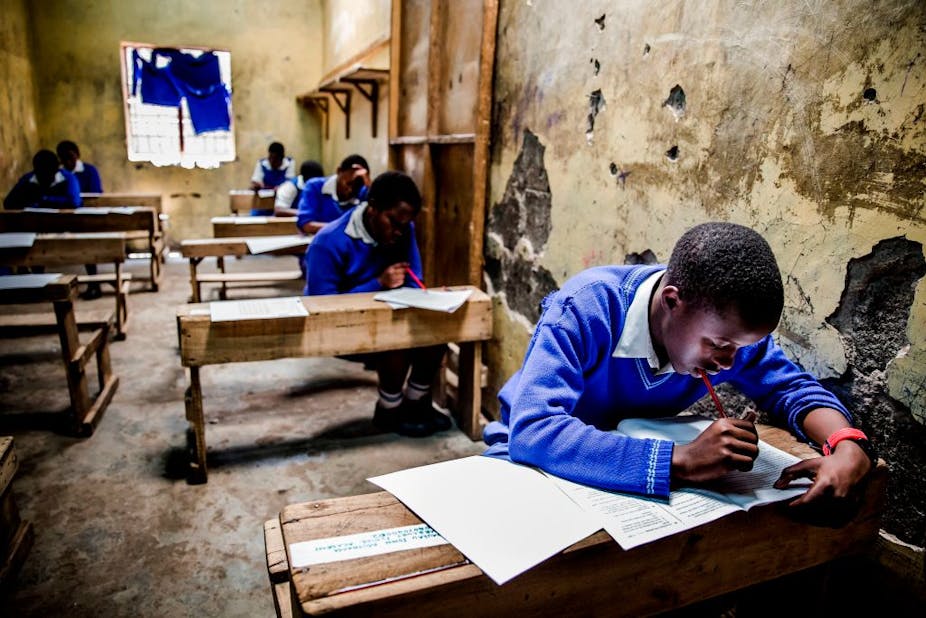It is widely recognised that education is a public good, which should be accessed by all, as a human right - irrespective of someone’s gender and socioeconomic or disability status. It is a goal that’s enshrined in the fourth Sustainable Development Goal.
Yet, the right to education for children is not assured, particularly for those who come from poor households - where decisions have to be made on who goes school - and also for girls. Because of gender norms across sub-Saharan Africa, girls of every school-age group are more likely to be excluded from education than boys.
One of the main challenges is for children to finish primary school, and then transition to secondary school. For instance, a study in 2010 estimated that the transition rate for pupils living in slums was 46%, compared to 72% for pupils in non-slum households.
My colleagues and I, at the African Population Health Research Center (APHRC), wanted to see what needed to happen to ensure that all children in urban informal settlements proceeded to secondary school and improved grades, leadership skills and social behaviour.
To do this, in 2013, we launched the “Advancing learning outcomes and transformational change” (A LOT Change), programme in two low income settlements: Korogocho and Viwandani. We did this in partnership with community groups that work with teenage boys and girls: Miss Koch Kenya and U-Tena Youth Organisation.
Over six years, the programme implemented an after-school support and life skills mentorship programme, provided subsidies, exposed parents to guidance and counselling, and helped young people to develop leadership skills.
We found that the project improved transition rates, exam scores and gave young people more confidence. This is encouraging and presents a model that can be scaled to improve learning outcomes and transition rates for young people living in urban informal settlements.
The programme
This programme was implemented in two phases. There was also a control group which allowed us to compare the impact that the programme had.
The first phase targeted 2,132 girls aged between 12 and 19 years, their parents and community leaders in the two urban informal settlements.
After-school support sessions were held within the community. These were one hour sessions, twice a week which covered literacy and numeracy. The support was provided by mentors - young people from the community that had achieved a grade of C+ or above in their end-of-secondary school examinations.
The life skills programme was also run by mentors who would spend an hour every month talking to the young people about the challenges of growing up in urban informal settlements. They would cover topics such as; values, self-awareness, self-esteem, drug and substance abuse, relationships, HIV/AIDS, effective communication, effective decision-making, career goals and sexual and reproductive health.
Parents were also given guidance and counselling - by counsellors from the communities - to encourage them to provide support for the education and schooling of children who are at risk of not completing primary or secondary school, or not able to transit to secondary school. These one hour sessions took place once a month for the first three months and once every quarter for the remainder of the project duration.
Finally, subsidies were provided to all students who transitioned to secondary school and scored above 250 marks in the Kenya Certificate of Primary Education (KCPE) examination. This was meant to help them cover some of the costs of joining secondary school, namely buying items like uniforms.
Including boys
As the first phase came to an end, data showed that programmes needed to target young men too. For instance, data showed that the secondary school transition rates for girls, which stood at 69.1%, was 5% higher than that of the boys.
Boys were being left behind. If the project was going to be truly inclusive, it was important to include boys. The conditions of slum life affect girls and boys from poor and disadvantaged households in a similar way.
To address this, in phase 2, boys were included as a target group and a leadership skills component was added to the programme. This phase targeted a total of 824 young people in the two sites.
Successes
When we evaluated both phases we found that, over time, students developed better grades in numeracy and literacy.
In terms of overall transition to secondary school - between 2014 and 2015 - 68% of girls in this study progressed to secondary school. This transition rate was 22% higher than before. Though it was still 9% lower than the national average.
The girls in the intervention group were also 62% more likely to aspire for education past secondary school.
We also found that, for all students, they became more self-assertive and were able to speak up more for their rights.
There were several aspects of the programme, in particular, that contributed to these successes.
The after-school support programme gave young people additional support with homework, which helped them a great deal.
The parental counselling - which allowed parents to get involved in their childrens’ education - gave them positive aspirations and encouraged them to resist negative peer influence.
Finally, the leadership component drove self-confidence - which made them approach learning and schooling with more determination to succeed.
Moving forward, there’s a final phase of the programme - to follow the cohort of girls and boys from phase 2 - which is a three year programme. This started in April 2019 and will run up to April 2022. This programme comprises of mentorship in life skills, career awareness, social responsibility and citizenship skills, parental support for children’s education, homework support and digital literacy.
We look forward to seeing how this phase of the programme continues to foster equity, inclusion, and equality for both girls and boys in secondary school.

